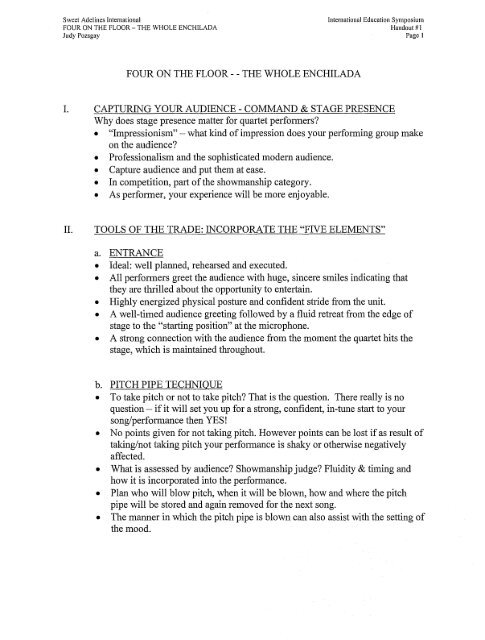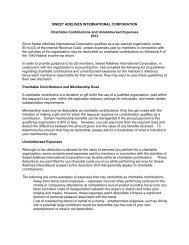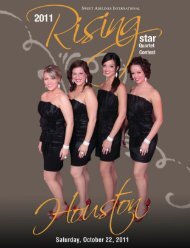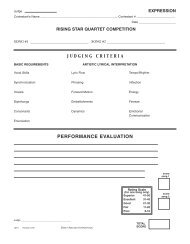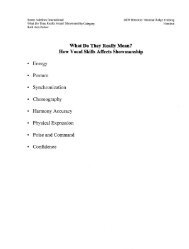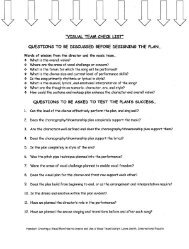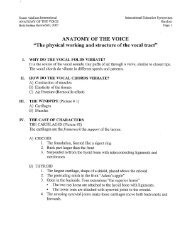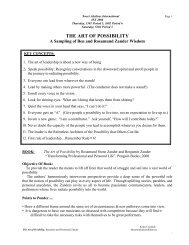PDF Image - Sweet Adelines International
PDF Image - Sweet Adelines International
PDF Image - Sweet Adelines International
Create successful ePaper yourself
Turn your PDF publications into a flip-book with our unique Google optimized e-Paper software.
<strong>Sweet</strong> <strong>Adelines</strong> <strong>International</strong><br />
FOUR ON THE FLOOR - THE WHOLE ENCHILADA<br />
Judy Pozsgay<br />
<strong>International</strong> Education Symposium<br />
Handout#!<br />
Page!<br />
FOUR ON THE FLOOR - - THE WHOLE ENCHILADA<br />
I. CAPTURING YOUR AUDIENCE - COMMAND & STAGE PRESENCE<br />
Why does stage presence matter for qUaliet performers?<br />
• "Impressionism" - what kind ofimpression does your performing group make<br />
on the audience?<br />
• Professionalism and the sophisticated modem audience.<br />
• Capture audience and put them at ease.<br />
• In competition, pali ofthe showmanship category.<br />
• As perfOlmer, your experience will be more enjoyable.<br />
II.<br />
TOOLS OF THE TRADE: INCORPORATE THE "FIVE ELEMENTS"<br />
a. ENTRANCE<br />
• Ideal: well plamled, rehearsed alld executed.<br />
• All performers greet the audience with huge, sincere smiles indicating that<br />
they are thrilled about the opporhmity to enteliain.<br />
• Highly energized physical posture and confident stride from the unit.<br />
• A well-timed audience greeting followed by a fluid retreat from the edge of<br />
stage to the "starting position" at the microphone.<br />
• A strong cOlmection with the audience from the moment the quartet hits the<br />
stage, which is maintained throughout.<br />
b. PITCH PIPE TECHNIQUE<br />
• To take pitch or not to take pitch? That is the question. There really is no<br />
question - ifit will set you up for a strong, confident, in-tune stali to your<br />
song/performance then YES!<br />
• No points given for not taking pitch. However points can be lost ifas result of<br />
taking/not taking pitch your performance is shaky or otherwise negatively<br />
affected.<br />
• What is assessed by audience? Showmanship judge? Fluidity & timing and<br />
how it is incorporated into the perfomlance.<br />
• Plan who will blow pitch, when it will be blown, how and where the pitch<br />
pipe will be stored and again removed for the next song.<br />
• The manner in which the pitch pipe is blown Call also assist with the setting of<br />
the mood.
<strong>Sweet</strong> <strong>Adelines</strong> <strong>International</strong><br />
FOUR ON THE FLOOR - THE WHOLE ENCHILADA<br />
Judy Pozsgay<br />
<strong>International</strong> Education Symposium<br />
Handout #1<br />
Page 2<br />
c. TRANSITIONS / TIMING AUDIENCE APPLAUSE<br />
• The "non-singing" palis ofyour performance - key is that you are still<br />
performing! Planning and rehearsing tius supports the professionalism ofyom<br />
performance.<br />
• Must keep the audience cOlmection/interest. Don't want them to use tills<br />
break in the music as time to leave to use the restroom!<br />
• Remember, you are still on stage and you are all visible! Do not adjust yom<br />
costume, scratch your face, etc. Maintain the energized posture, involved face<br />
and be attentive to what is happening.<br />
• Keep tlus fluid. Ifyou are between songs, move with purpose from one place<br />
to the next, and ensure your posture is confident and energized.<br />
• Applause Acceptance: Gauge yom audience while you are accepting applause<br />
alld begin to retreat back to the microphone (or leave the stage) when you feel<br />
the crest ofthe wave ofapplause. You do not wish to be standing in "applause<br />
acceptallCe" mode when the applause has started to wane; this leads to a gap<br />
in the flow and can create audience & performer discomfOli.<br />
• Setting the Mood: The trallsition period Call also contribute to your<br />
perfonnallce by creating the atmosphere/mood for your next song. Facial<br />
expression, body posture, speed and tillung can all assist the performer in<br />
preparing the audience for a ballad or uptune performallce. It can be janing to<br />
the audience ifa conflicting message is provided during the transition/set up<br />
ofthe next song.<br />
d. EMCEE<br />
• Not a class on emcee tecluuque, however the manner in which the speaker<br />
approaches the microphone and addresses the audience is definitely a part of<br />
the whole enchilada! Energy, postme and manner ofspeech Call maintain the<br />
audience cOlmection.<br />
• When addressing the audience, remember to vary the tone ofyour speech and<br />
look at the audience.<br />
• Practice good microphone tecluuque.<br />
• Plalvscript what you will say in advance and rehearse this! Plan for audience<br />
response (for eXalnple ifyou are hoping for laughter!) alld time accordingly.<br />
• Remember that you aloe there to enteliain the audience and keep them at ease.<br />
Do your best to know your audience demographic before a perfonnance and<br />
plan your material accordingly. Never include offensive or inappropriate<br />
material/subject matter in your script.<br />
• Non-speaking members are still in perfonnallce mode and should be attentive,<br />
engaged and energized while taking a "back seat" to the emcee. Pay attention<br />
to what is happening - you never know when sometillng might happen on<br />
stage and you might need to improvise! Ifyou don't appear interested in what
<strong>Sweet</strong> <strong>Adelines</strong> Intemational<br />
FOUR ON THE FLOOR - THE WHOLE ENCHILADA<br />
Judy Pozsgay<br />
<strong>International</strong> Education Symposium<br />
Handout #1<br />
Page 3<br />
your quartet-mate is saying to the audience, the audience won't be interested<br />
either! Remember, the audience takes their cues from you the performer!<br />
• Emcee spot should flow with the rest ofthe performance and getting in and<br />
out ofthe emcee spot should be seamless.<br />
e. EXIT<br />
You are almost done! You want to leave a positive, lasting impression so be<br />
sure you are still performing until you leave the stage!<br />
• The same confident, energized manner with which you took the stage is the<br />
ideal way to leave your audience. Maintain eye contact, have gracious smiles<br />
and leave the audience feeling like it was your pleasure to have enteliained<br />
them!<br />
• Ifyou are unhappy with your performance, or the audience response, or one of<br />
your quartet-mates, don't let the audience know! An otherwise wonderful<br />
audience experience might be tainted with a hasty qUaliet retreat from the<br />
stage, or faces that reveal discomfOli or unhappiness with the performance.<br />
• Ifappropriate, you can show some creativity alld incorporate the character or<br />
theme from your perfonnance into the exit.<br />
III.<br />
"THE WHOLE ENCHILADA"<br />
• A successful perfOnnallCe includes the whole package: the music, the visual<br />
plan, the posture, the grooming, the facial expressions, the pacing, the<br />
costuming, alld the energy field - that makes up stage presence.<br />
• Plan it! Practice it!<br />
• Understand that this is something that takes practice alld experience.<br />
• You Call falee confidence and it Call eventually become genuine!<br />
• Understalld that this is something you owe your audience, and you owe<br />
yourself as a perfOlmer. Focus more on the audience and "giving it away" alld<br />
it will be more natural for you.<br />
The audience is there to listen alld watch you perfonn! Give 'em what they deserve - give<br />
'em the WHOLE ENCHILADA!


